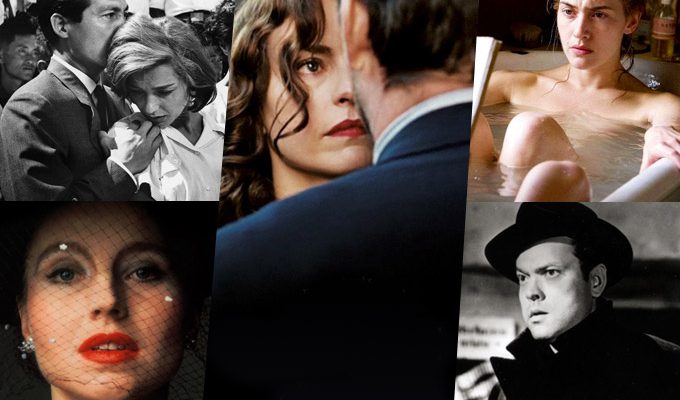 “I Live In Fear” (1955)
“I Live In Fear” (1955)
Sandwiched in between classics like “Seven Samurai” and “Throne of Blood,” it’s not hard to understand why Akira Kurosawa’s “I Live In Fear” is underseen and underappreciated. And comparatively it may be the least actively “post-war” drama on this list, but of all Kurosawa’s post-war era films, its atomic age fears make it the most directly related to the subject. Set in the wake of Hiroshima, the movie centers on a family court mediator as he comes upon an extremely odd, dramatic case: a family trying to declare their wealthy patriarch mentally incompetent because the elderly doyen harbors deep delusion and paranoia regarding atomic warfare. The father, Kiichi Nakajima (the great Toshiro Mifune), has spent millions trying to move their operations to Northern Japan and to build underground shelters, but worse still, Kiichi has a greater obsession: a plan to move the entire family (plus his mistresses and all resulting illegitimate children!) and business to Brazil, no doubt wasting their entire family fortune in the effort. Kurosawa’s movie then chronicles the miserable, unbalanced mental state of the father, as well as the embittered clan, some of whom are genuinely suffering from the same illness (and the humiliating embarrassment of Japan’s defeat) that haunts their father, while others are opportunistically worried about their cut, while the sympathetic adjudicator soberly contemplates this troublesome dilemma bearing down on his shoulders. The restrained but doleful “I Live In Fear” is thus a soft but pointed minor tragedy filled with an aching low-key melancholy as it quietly traces the unseen and even more upsetting fallout of war’s end; the cultural anxiety and terror of living in the uneasy shadow of the bomb.
 “Europa” (1991)
“Europa” (1991)
Before there was “Nymphomaniac,” before Dogme and before Cannes scandals in which he joked about being a Nazi, Lars Von Trier made “Europa” (released as “Zentropa” in the U.S. but now more commonly known by its original title). The final film in a thematic trilogy, all of which deal in more or less hallucinatory, metaphorical fashion with the devastation of post-war Europe, “Europa” is the most on point in that regard, detailing an idealistic, pacifist American (Jean-Marc Barr) coming to Germany immediately after the war to take up a position as a night-car guard on the railroad. Quickly embroiled in a morass of contradictory political influences, he falls for the daughter (Barbara Sukowa) of the railroad owner/industrialist, whose own hands may not be clean of Nazi involvement, while also being an unwitting pawn in the chess-game played by corrupt Allied occupiers and partisan Germans, known as “werewolves” resisting occupation. Shot in striking monochrome and with technicolor flourishes (the astonishing underwater shot of red blood dripping into a bath is more impressive than all of “Sin City”), the film is heavily indebted to film noir, and from there to German Expressionism’s heightened sets and harsh directional lighting. And because it is Von Trier, it’s a deeply pessimistic film, heaving with a sort of coiled self-disgust in reserving its most scathing judgment not for the Allies or the Nazis, but for the people who never chose sides. This is the post-war era imagined as a post-apocalypse, a doomy place in which the recent past is so inescapable that it reaches through the present to choke the very idea of a future. Surprisingly, one of the film’s most successful flourishes, the second-person voiceover from Max Von Sydow, was only added for international release, but its countdown motif is appropriate: in “Europa,” time is always on the verge of running out and the future is an oncoming black tunnel from which we may never emerge.
 “Hiroshima, Mon Amour” (1959)
“Hiroshima, Mon Amour” (1959)
One of the most beautiful and emotionally vivid films ever made, Alain Resnais‘ influential excavation of memory and forgetfulness, “Hiroshima, Mon Amour” is an extraordinary work of art that locates the psychological scars of the war just ended in the mayfly relationship between a French woman and a Japanese man. Unfolding through stunningly evocative images (glistening ash falling on naked entwined limbs, looming buildings, neon Japanese signage, Emmanuelle Riva‘s hair, Eiji Okada‘s face), the film is told in a series of conversations between the two, mostly She relating her fragmentary recollections, only to be frequently contradicted by He. It’s undeniably arch, a self-consciously experimental construction of a film, but it rushes past with the logic not of a dream but of a memory that you’re trying to hold on to, even though the act of remembrance might bring you pain, and might dredge up buried shame. At moments, the manipulated, self-involved air of poetic melodrama can almost seem too much, too overwhelming to any sense of the film’s realism, but Resnais, working from Marguerite Duras‘ complex, indulgent script, always pulls back from the brink of overflow, casting many of these almost absurdly heightened exchanges against Sacha Vierny‘s rich but deceptively simple visuals, and even, on occasion, using documentary footage of the survivors of the atom bomb to jolt us back into immediacy. This is cinema as intoxication, drunk on guilt and passion (the film is desperately involved with the folly of doomed love) and full of heartbreak for all things the bomb, and the war, killed or maimed. Here, the post-war era seems so much more crushing for not dealing in life-or-death stakes, but in the tragedy of survival. It becomes a poem and a dirge for those who lived, and the endemic survivor’s guilt experienced by an entire generation.

